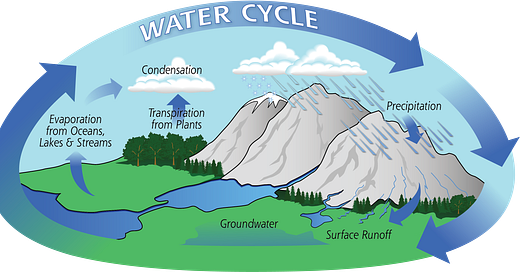America Is Using Up Its Groundwater Like There’s No Tomorrow
This recent piece caught my attention and got me thinking how little I know about the water cycle. How can it be that something so essential to life is becoming scarce? As the article states, “Many of the aquifers that supply 90 percent of the nation’s water systems, and which have transformed vast stretches of America into some of the world’s most bountiful farmland, are being severely depleted.”
What does this really mean when it seems like we can always get more water when it rains?
In order to answer some of my questions I got in touch with Amanda Lounsbury who is a chemical and environmental engineering scientist with 14 years of experience in sustainability applications, especially in the energy-water nexus space and currently works as a contractor for the US Department of Energy.
The views and opinions expressed here are those of the authors and do not necessarily reflect the official policy or position of the Department of Energy.
What originally caught my attention was the dwindling groundwater that Americans rely on for agriculture as well as drinking. Can you explain the difference between groundwater and the water cycle that relies on rain?
All water is connected -groundwater, surface water, ocean water, ice! The difference between surface and ground water is a matter of time scales. Groundwater is found in cavities in the Earth’s surface. When we talk about groundwater, there is “fossil” groundwater, usually in much deeper wells, that are a result of ancient environments. It can take thousands of years for surface water to reach these old deep aquifers, if at all. There are also younger shallower groundwater aquifers into which surface water trickles in more quickly - even as fast as hours.
Surface water, as it sounds, is above ground, on the surface. Melted ice in the mountains, underground springs, and rain source most natural surface water. With warm temperatures water evaporates and rises. As it rises it cools and condenses to form rain or snow where it then continues to feed surface water or young aquifers through groundwater recharge. USGS recently published an excellent new figure of the water cycle, that I recommend everyone look at here.
How are these systems being threatened?
In general, our current way of living and providing freshwater is not sustainable. Mountain snow and ice act as water storage that slowly melt over time. As temperatures rise snow falls later and melts sooner, meaning that the natural cycle of water is off. This means there are greater flooding events when that water would have been held onto as snow/ice and less water in drier months when that snow/ice would have melted. The flooding events cause problems with water quality, among other things, and water quantity issues in dry spells. We are also seeing changes in weather patterns more generally, felt especially by farmers who rely on surface water for irrigation. Changing weather patterns are disrupting traditional farming practices and make it harder to plan.
Groundwater is also threatened. Similarly to surface water the way in which groundwater is threatened is regionally dependent. There are two major issues:
1) Contamination of groundwater either through contaminants leeching through the soil or through existing wells that pollute fossil aquifers and
2) Overpumping of groundwater. The overpumping of groundwater can result in dry wells, sink holes, and/or saltwater intrusion (the contamination of fresh groundwater with salt water) which is exacerbated by sealevel rise. In some areas we have diverted surface water and paved surfaces for cities and towns that have resulted in slowing down of groundwater recharge (the refilling of groundwater).
As for water reuse in general, how does that work? We have all heard of waste-water treatment but what are other ways water is being reused? How can we avoid a water crisis as supplies dwindle?
As we experience a growing need for water but less availability of potable (drinkable) water, we must increasingly turn to alternative water sources including reusing water. Water reuse is a very broad term. Reuse of some water like municipal wastewater (what goes down your drain at home) happens indirectly all the time, if you live down river of a city or a town, your drinking water is really their treated wastewater.
In the water space we speak a lot about “fit-for-purpose” water. This means, we treat the water only to the extent it needs to be treated to be reused. Treatment of water is very energy/resource intensive (and expensive).
Municipal wastewater is often used for irrigation purposes. Scientists are still studying what the impacts of this are and what contaminants make it out of current treatment systems. When you see or hear of the “purple pipe system” this is treated wastewater that is being used to irrigate.
Ultimately it is state law along with technological capacity to treat that water to the necessary degree to protect environmental and human health (i.e. water that you use to irrigate a golf course does not need to be the same quality as water used to drink) that determines the ability to reuse water.
The United States EPA has a marvelous database the ReUse Explorer that shows what the reuse regulations are across the US for reuse. If reuse is something you are interested in, I would make sure this is something you bring up to your state government.
On the technology side, the federal government is working together under the Water Reuse Action Plan to help promote water reuse.
What are some innovative technologies you have seen in the space you hope the US adopts in the near future?
The US has made some seriously strong strides in the water space. We all know about desalination and wastewater reuse but really in the last 5-10 years I’ve started to see a lot of renewed interest in the space by private companies and venture capital firms like Burnt Island Ventures and Xylem’s Accelerator Program that support water tech.
Additionally, the US Department of Energy has a whole bunch of energy-water technologies that they are funding for development especially in desalination, sensing, climate and water reuse areas.
What I really hope we start to adopt are technologies that address circular issues like how can we combine hydrogen production or carbon capture with water treatment? How do we turn wastewater into the energy and nutrient rich source that it inherently is? How do we address grid resiliency and farming? How do we create value out of something that we expect to be free but is expensive to produce (water)? We are far from these more circular solutions and that is why there is so much interest from government including implementation of the Energy Act of 2020 that called for an R&D office to address energy-water for sustainability.
As an expert in the space, what concerns you most about the way we are living?
With regard to water, I think my biggest concern is that water is a necessary resource -it is necessary for almost every aspect of human life -a certain amount of it needs to be free from an equity standpoint, from a survival standpoint, but water is not free to produce or transport and unless it is a bottle of water from the store (which is no different than the water from your tap) we aren’t willing to pay for it. If water is a necessary resource that is significantly undervalued and underpaid for we will continue to use it until one day we turn on our tap and nothing will come out.
In addition to our water pricing we also think we need to reassess our water rights. We need to start treating water as the valuable resource it is!
Traditionally we have treated water as a separate free resource rather than thinking about it as part of interdependent cycles. So for example, as we push toward a low carbon world, people often forget to think about what this means for water (and other metrics of global and environmental health) or the role that water will play as part of this transition. I think it is so important for us to think about problems holistically and how things are interconnected and how we weigh these interconnected issues. That is what sustainability is really about and really the only way to think about it. Time scales and interconnected entities.
Gems of the Week 💎
I signed up for a cooking course with the Plant Academy! If you are looking for some fundamental plant-based recipes and techniques, they are starting a 6-week program called From Scratch tomorrow.
Somehow I found myself in a bookclub reading The Power Broker: Robert Moses and the Fall of New York with an environmental justice lens. This is a dense book but especially living in Rockaway the history is incredible.
I walked into a Glossier last week and purchased another Boy Brow. Though the name is silly I am loving what it does for my eyebrows.
I am a big Esther Perel fan and she is going on tour! If you don’t know her work I can’t recommend enough. Start here
Chef Mehreen Karim had a pop up at Farm to People this month and I finally got to try the food on Friday. I ordered the Cara Cara Orange Salad with Candied Pistachios and Fried Shallots, Disco Fries and Brussel Sprouts with Coconut Tahini Dressing and Grapes.
Shaved Broccoli and Beans with Halloumi and Orange Vinaigrette ✨
Not only am I bean obsessed, when discussing water use, beans are extremly efficient compared to other proteins. A serving of beef takes 463 gallons per four-ounce serving while black beans take only 49 gallons.
I’m figuring out the formula how to make a delicious bean dish. Some veggies, perfectly cooked dry beans, cheese and something crunchy.
My dad sent me a recent piece by Eric Kim - The Best Bowl of Beans I’ve Ever Had.
I didn’t think I could find the oil cured olives but wanted to make another batch of beans with parmesan rind. My instant pot had a bit of a malfunction so I did it on the stove top and since the dry beans I used were small they were cooked in a hour! I used Rancho Gordo’s Buckeye Beans. If you are not buying premium beans yet, this is your sign.
INGREDIENTS
Two heads of broccoli
1/2 lb dry beans (I always make 1lb and save the extra)
Halloumi (sub for any cheese if you don’t have)
Sunflower Seeds
1 Orange
Olive Oil
Champagne or White Vinegar
Any jam (I used Yuzu) or honey
INSTRUCTIONS
Cook your dry beans. I added 1 lb to a pot with enough water to cover, 2 bay leaves, 1 parm rind and a couple stick of thyme. Brought to boil and let simmer for an hour
Chop up the broccoli head to make tiny pieces (save the stems for another meal)
In a bowl squeeze the orange, add 4 glugs olive oil and 1 splash vinegar. Mix in a spoonful of jam or honey and whisk. Adjust to your liking
Once all the other elements are ready, melt your halloumi in a pan until brown
Top with sunflower seeds






